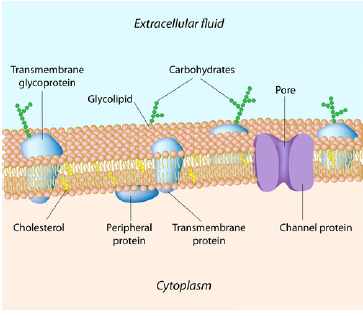Reading: Cell Transport
Cell Transport - Advanced
Douglas Wilkin, Ph.D.Niamh Gray-Wilson
http://www.ck12.org/saythanks
• Describe the importance of cell transport.
What is cell transport?
It is the movement of substances across the cell membrane either into or out of the cell. Sometimes things just move through the phospholipid bilayer. Other times, substances need the assistance of a protein, like a channel protein or some other transmembrane protein, to cross the cell membrane.Cell Transport
Cell transport refers to the movement of substances across the cell membrane. Probably the most important feature of a cell’s phospholipid membranes is that they are selectively permeable. A membrane that is selectively permeable, or semipermeable, has control over what molecules or ions can enter or leave the cell, as shown in Figure 1.1. This feature allows a cell to control the transport of materials, as dictated by the cell’s function. The permeability of a membrane is dependent on the organization and characteristics of the membrane lipids and proteins. In this way, cell membranes help maintain a state of homeostasis within cells (and tissues, organs, and organ systems) so that anorganism can stay alive and healthy.

FIGURE 1.1
A selectively permeable, or semipermeable,
membrane allows certain molecules
through, but not others.
Transport Across Membranes
The molecular make-up of the phospholipid bilayer limits the types of molecules that can pass through it. For example, hydrophobic (water-hating) molecules, such as carbon dioxide (CO2) and oxygen (O2), can easily pass through the lipid bilayer, but ions such as calcium (Ca2+) and polar molecules such as water (H2O) cannot. The hydrophobic interior of the phospholipid bilayer does not allow ions or polar molecules through because they are hydrophilic, or water loving. In addition, large molecules such as sugars and proteins are too big to pass through the phospholipid bilayer. Transport proteins within the membrane allow these molecules to cross the membrane into or out of the cell. This way, polar molecules avoid contact with the nonpolar interior of the membrane, and largemolecules are moved through large pores.
Every cell is contained within a membrane punctuated with transport proteins that act as channels or pumps to let in or force out certain molecules. The purpose of the transport proteins is to protect the cell’s internal environment and to keep its balance of salts, nutrients, and proteins within a range that keeps the cell and the organism alive.
There are four main ways that molecules can pass through a phospholipid membrane. The first way requires no energy input by the cell and is called simple diffusion. This type of transport includes passive diffusion and osmosis.
No assistance by a transport is necessary in simple diffusion. Facilitated diffusion, does involve the assistance of transport proteins. The third way, called active transport, requires that the cell uses energy to pull in or pump out certain molecules and ions. Active transport involves proteins known as pumps. The fourth way is through vesicle transport, in which large molecules are moved across the membrane in bubble-like sacks that are made from pieces of the membrane. Vesicular transport includes exocytosis and endocytosis.
Homeostasis and Cell Transport
Homeostasis refers to the balance, or equilibrium, within the cell or a body. It is an organism’s ability to keep a constant internal environment. Keeping a stable internal environment requires constant adjustments as conditions change inside and outside the cell. The adjusting of systems within a cell is referred to as homeostatic regulation. Because the internal and external environments of a cell are constantly changing, adjustments must be made continuously to stay at or near the normal proportions of all internal substances. This involves continual adjustments in transport of substances across the cell membrane. Homeostasis is a dynamic equilibrium rather than an unchanging state. The cellular processes discussed in the cell transport (passive and active transport) concepts all play an important role in homeostatic regulation.Vocabulary
• concentration gradient: Difference in the concentrations of a molecule across two distinct areas, such as a cell membrane.
• diffusion: The movement of molecules from an area of high concentration of the molecules to an area with a lower concentration.
• endocytosis: The cellular process of capturing a material/substance from outside the cell by vesicle formation.
• exocytosis: The cellular process of secreting materials by vesicle fusion.
• homeostasis: The process of maintaining a stable environment inside a cell or an entire organism.
• passive transport: Transport of small molecules or ions across the cell membrane without an input of energy by the cell.
• selectively permeable: The ability to allow only certain molecules to cross the plasma membrane; semipermeable.
• semipermeable: The feature of a cell membrane that allows only select molecules (ions and organic molecules) to enter and/or leave the cell; the ability to allow only certain molecules to cross the plasma membrane; selectively permeable.
Summary
• The cell membrane is selectively permeable, allowing only certain substances to pass through.• Cell transport may require assistance by a protein/pump.
• Cell transport may require energy.
• Some transport involves vesicles.
Review
1. What is meant by cell transport? Why is cell transport important?2. List types of cell transport.
3. Explain how cell transport helps an organism maintain homeostasis.
